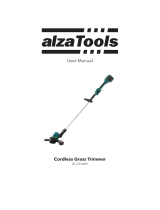Stanley SFMCSTB933M User manual
- Category
- Power tools
- Type
- User manual
Stanley SFMCSTB933M is a brushless grass trimmer with a cutting swath size of 330 mm, ideal for trimming lawns and gardens. Powered by an 18V battery, it offers a variable speed of 4600-6000 RPM for precise cutting. Its lightweight design and ergonomic handle ensure comfortable handling, while the adjustable cutting head allows for easy edging and trimming. Safety features include a blade guard to protect the user from flying debris. For added convenience, the trimmer comes with a bump feed system for quick and easy line advancement.
Stanley SFMCSTB933M is a brushless grass trimmer with a cutting swath size of 330 mm, ideal for trimming lawns and gardens. Powered by an 18V battery, it offers a variable speed of 4600-6000 RPM for precise cutting. Its lightweight design and ergonomic handle ensure comfortable handling, while the adjustable cutting head allows for easy edging and trimming. Safety features include a blade guard to protect the user from flying debris. For added convenience, the trimmer comes with a bump feed system for quick and easy line advancement.
















-
 1
1
-
 2
2
-
 3
3
-
 4
4
-
 5
5
-
 6
6
-
 7
7
-
 8
8
-
 9
9
-
 10
10
-
 11
11
-
 12
12
-
 13
13
-
 14
14
-
 15
15
-
 16
16
Stanley SFMCSTB933M User manual
- Category
- Power tools
- Type
- User manual
Stanley SFMCSTB933M is a brushless grass trimmer with a cutting swath size of 330 mm, ideal for trimming lawns and gardens. Powered by an 18V battery, it offers a variable speed of 4600-6000 RPM for precise cutting. Its lightweight design and ergonomic handle ensure comfortable handling, while the adjustable cutting head allows for easy edging and trimming. Safety features include a blade guard to protect the user from flying debris. For added convenience, the trimmer comes with a bump feed system for quick and easy line advancement.
Ask a question and I''ll find the answer in the document
Finding information in a document is now easier with AI
Related papers
-
Stanley SFMCST933 User manual
-
Stanley FMC705 User manual
-
Stanley SFMCPW1500B User manual
-
Stanley SFMCBL7 Owner's manual
-
Stanley SFMCSTB933M User manual
-
Stanley FATMAX V60 Owner's manual
-
Stanley FATMAX SFMCST933 Owner's manual
-
Stanley SFMCHT855 User manual
-
Stanley SFMCPH845 User manual
-
Stanley SFMCPH845 User manual
Other documents
-
Greenworks Pro ST60L00 Operating instructions
-
Powerbase N0F-GT-250/20-E Owner's manual
-
Kmart 42578925 User manual
-
 alzaTools AT-CSC40V Cordless Grass Trimmer User manual
alzaTools AT-CSC40V Cordless Grass Trimmer User manual
-
Greenworks Pro STBA60L210 Operating instructions
-
Greenworks Pro STBA80L210 Operating instructions
-
Simplicity STRING TRIMMER, 48 V, SNP User manual
-
Hyundai HYTR60Li User manual
-
Black & Decker ST1823 User manual
-
Greenworks Pro ST80L210 Operating instructions
















